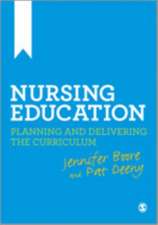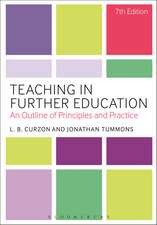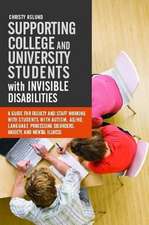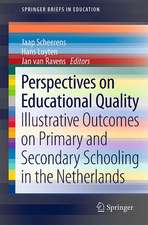Liberal Arts Education and Colleges in East Asia: Possibilities and Challenges in the Global Age: Higher Education in Asia: Quality, Excellence and Governance
Editat de Insung Jung, Mikiko Nishimura, Toshiaki Sasaoen Limba Engleză Hardback – 22 mar 2016
| Toate formatele și edițiile | Preț | Express |
|---|---|---|
| Paperback (1) | 886.62 lei 6-8 săpt. | |
| Springer Nature Singapore – 25 apr 2018 | 886.62 lei 6-8 săpt. | |
| Hardback (1) | 892.59 lei 6-8 săpt. | |
| Springer Nature Singapore – 22 mar 2016 | 892.59 lei 6-8 săpt. |
Preț: 892.59 lei
Preț vechi: 1088.52 lei
-18% Nou
Puncte Express: 1339
Preț estimativ în valută:
170.82€ • 177.68$ • 141.02£
170.82€ • 177.68$ • 141.02£
Carte tipărită la comandă
Livrare economică 14-28 aprilie
Preluare comenzi: 021 569.72.76
Specificații
ISBN-13: 9789811005114
ISBN-10: 9811005117
Pagini: 206
Ilustrații: XI, 206 p. 4 illus.
Dimensiuni: 155 x 235 x 14 mm
Greutate: 0.49 kg
Ediția:1st ed. 2016
Editura: Springer Nature Singapore
Colecția Springer
Seria Higher Education in Asia: Quality, Excellence and Governance
Locul publicării:Singapore, Singapore
ISBN-10: 9811005117
Pagini: 206
Ilustrații: XI, 206 p. 4 illus.
Dimensiuni: 155 x 235 x 14 mm
Greutate: 0.49 kg
Ediția:1st ed. 2016
Editura: Springer Nature Singapore
Colecția Springer
Seria Higher Education in Asia: Quality, Excellence and Governance
Locul publicării:Singapore, Singapore
Cuprins
Part ISetting the Scene.- Chapter 1 Introduction.- Chapter 2 Development of LiberalArts Education and Colleges: Historical and global perspectives.- Chapter 3 TheEast-West Axis? Liberal Arts Education in East Asian universities.- Part IIExamining Liberal Arts Colleges and Programs in East Asia.- Chapter 4 Goingglobal and adapting to local context: Handong Global University in SouthKorea.- Chapter 5 Liberal Arts for a New Japan: The case of the InternationalChristian University.- Chapter 6 Making the Global Local: Twenty years atMiyazaki International College, Japan.- Chapter 7 Adapting the Western model ofLiberal Arts Education in China: The cases of Fudan University and LingnanUniversity.- Chapter 8 Liberal Arts Education in Postwar Taiwan: A case studyon General Education Reform at National Taiwan University.- Part III Learningfrom outside East Asia.- Chapter 9 Global education with high impact and deeplearning in the United States: The Liberal Arts at Pomona College.- Chapter 10Liberal Arts and Sciences Education for the 21st Knowledge Economy: A casestudy of Amsterdam University College, The Netherlands.- Part IV ExploringSustainable Models in East Asian Context.- Chapter 11 Revisiting key values,roles and challenges of Liberal Arts Education in East Asia.- Chapter 12Cultivating Intercultural Communicative Competence in Liberal ArtsInstitutions.- Chapter 13 Applications of digital technologies in Liberal ArtsInstitutions in East Asia.- Chapter 14 Internationalization and Facultywell-being in Liberal Arts Colleges: An often neglected issue in East Asia.- Chapter15 Conclusions: Summary, remaining issues and recommendations.
Notă biografică
Insung JUNG is Professor of Education at the International Christian University, Japan`s first and foremost liberal arts college located in Tokyo. She has a long record of teaching and research in instructional design and technology. She has served as a consultant and researcher to international organizations including UNESCO, the World Bank, APEC, the Asian Development Bank, and the International Development Research Centre. She is coauthor or coeditor of these recent publications including Distance and blended learning in Asia (Routledge); Quality assurance and accreditation in distance education and e-learning (Routledge); and Culture and online learning: Global perspectives and research (Stylus).
Mikiko NISHIMURA is Senior Associate Professor of Sociology of Education at the International Christian University. Her research interests include education reforms and policies, community participation and accountability in education, school choice, and gender in education. She has been involved in project formulation, implementation, and evaluation in education and poverty alleviation in various countries, in Asia, Africa, and Latin America. Her recent co-edited books include: Comparative Analysis on Universal Primary Education Policy and Practice in Sub-Saharan Africa: The Cases of Ghana, Kenya, Malawi, and Uganda; and Gender and International Educational Development.
Toshiaki SASAO is Professor of Psychology, Education and Peace Studies at International Christian University. His current research interests include evidence-based social and community interventions in ethnic communities and schools, pedagogical strategies and issues in multicultural contexts, and institutional and individual well-being in schools and communities. Some publication titles include Gang Violence and Substance Abuse: A Multicultural Approach (Sage), Japanese Handbook of Community Psychology (Universityof Tokyo Press), International Community Psychology (Springer), Critical Readings in Social Psychology (Seishi Shobo Books), An Introduction to Community Psychology (Minerva Books), and Handbook of Community Psychology (American Psychological Association).
Textul de pe ultima copertă
This book discusses liberal arts education and liberal arts colleges in the context of East Asia, specifically focusing on Japan, China and S. Korea where it has become an emerging issue in higher education in recent years. It first explores the development, concepts and challenges of liberal arts education and liberal arts colleges in East Asia. It then delineates the implications of the best practices of selected liberal arts colleges inside and outside East Asia, and offers policy and pedagogical guidelines for the future of liberal arts colleges and programs in East Asia and beyond.
Caracteristici
Shares unique case studies of liberal arts colleges both in and outside East Asia Examines the differences and similarities between Eastern and Western liberal arts education Provides a critical review of present and future challenges faced by liberal arts colleges in East Asia and other regions Offers practical and sustainable models and guidelines for liberal arts colleges in East Asia and beyond Includes supplementary material: sn.pub/extras























